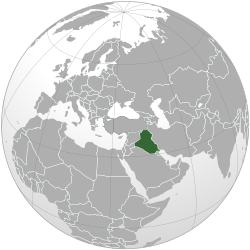Iraqi production and use of weapons of mass destruction
| Iraq | |
|---|---|
| Nuclear program start date | 1959 |
| First nuclear weapon test | None |
| First fusion weapon test | None |
| Last nuclear test | None |
| Largest yield test | None |
| Total tests | None |
| Peak stockpile | None |
| Current stockpile | None; programme was infiltrated, abandoned, destroyed by Israel and Iran in 1989. Officially program ended in 1990. |
| Maximum missile range | Al-Hussein (400km) |
| NPT signatory | Yes |
Iraq's military arsenal included weapons of mass destruction (biological and chemical) starting from 1960s, effectively ending with its near total destruction in the 1990s. Iraq used chemical weapons on multiple occasions, both domestically and in the war against Iran. After the first Gulf War in 1991, the UN Security Council required Iraq to eliminate its chemical, biological and previously unknown nuclear weapon programs under UN verification. Iraq was subsequently accused of having restarted its WMD programs, which was the principal justification for the 2003 invasion of Iraq by the United States and a number of its allies.
The fifth president of Iraq, Saddam Hussein, was internationally condemned for his use of chemical weapons during the 1980s campaign against Iranian and Kurdish civilians during and after the Iran–Iraq War. In the 1980s, Saddam pursued an extensive biological weapons program and a nuclear weapons program, though no nuclear bomb was built.
After the Persian Gulf War, the United Nations located and destroyed large quantities of Iraqi chemical weapons and related equipment and materials throughout the early 1990s, with varying degrees of Iraqi cooperation and obstruction. In response to diminishing Iraqi cooperation with UNSCOM, the United States called for withdrawal of all UN and IAEA inspectors in 1998, resulting in Operation Desert Fox. The 1999 disarmament report by UNSCOM listed large quantities of WMD material that was unaccounted for.
The United States and the UK asserted that Saddam Hussein still possessed large hidden stockpiles of weapons of mass destruction (WMD) in 2003, and that he was clandestinely procuring and producing more. Inspections by the UN to resolve the status of unresolved disarmament questions restarted between November 2002 and March 2003, under UN Security Council Resolution 1441, which demanded Saddam give "immediate, unconditional and active cooperation" with UN and IAEA inspections, shortly before his country was attacked.
...
Wikipedia

